Related Research Articles

The Aerocar Mini-IMP is a light aircraft designed by Moulton Taylor and marketed for homebuilding by Aerocar International. It is a scaled-down derivative of his original Aerocar IMP design. A two-seat version called the Bullet was also built. The Mini-IMP follows the same unconventional layout as its larger predecessor, with a center mounted engine, long driveshaft to a tail propeller, and inverted-V rudder/elevators.

The Evans VP-2 is a development of the Evans VP-1 Volksplane, both of which were designed in La Jolla, California by aeronautical engineer William Samuel "Bud" Evans. Evans had formerly worked at Convair, Ryan Aircraft and General Dynamics.

The Aerosport Scamp A is a small biplane designed for home building by Harris Woods. It featured an open cabin, tricycle undercarriage, and a T-tail.
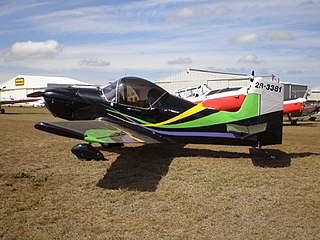
The Corby CJ-1 Starlet is a single seat, amateur-built aeroplane designed in the 1960s by Australian aeronautical engineer John Corby.
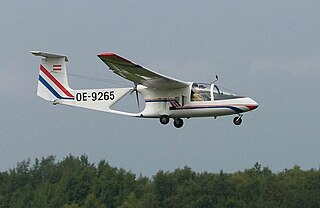
The Brditschka HB-3, HB-21 and HB-23 are a family of motor gliders of unorthodox configuration developed in Austria in the early 1970s.

The Breda A.4 was a biplane trainer produced in Italy in the mid-1920s. It was of conventional configuration with a two-bay unstaggered wing cellule and seating for the pilot and instructor in tandem open cockpits. Apart from civil use, the A.4 was also adopted by the Regia Aeronautica as a trainer. At least some examples were produced in floatplane configuration as the A.4idro.

The Brügger MB-1, MB-2 and MB-3 Colibri is a family of small sports aircraft designed in Switzerland in the 1960s and 1970s for amateur construction.
The Cvjetkovic CA-61 Mini-Ace is a 1960s American homebuilt monoplane aircraft designed by Anton Cvjetkovic.
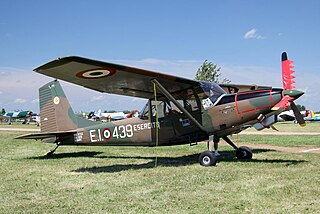
The SIAI-Marchetti SM.1019 is an Italian STOL liaison monoplane built by SIAI-Marchetti for the Italian Army, and based on the Cessna O-1 Bird Dog.
The Gatard Statoplan AG 02 Poussin was a light, single-seat sports airplane developed in France in the late 1950s and marketed for homebuilding. In layout, it was a low-wing cantilever monoplane of short-coupled design with fixed tailwheel undercarriage. Construction was a plywood-covered wooden structure throughout, and the cockpit was enclosed by a large perspex bubble canopy. The variable-incidence horizontal stabiliser was fitted with small endplates to provide extra directional stability but there were no separate elevators.
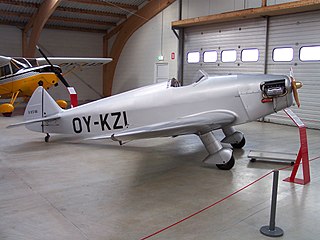
The SAI KZ I was a sport aircraft built in Denmark in 1937, the first aircraft built by the Kramme & Zeuthen firm.

The Wassmer WA-80 Piranha is a French two-seat low-wing cabin monoplane trainer designed and built by Société Wassmer. Based on the same construction as the company's WA-50 four-seater, the WA-80 was a scaled down version. The prototype, registered F-WVKR, first flew in November 1975 powered by a 100 hp Rolls-Royce Continental O-200 engine. Wassmer appointed a receiver and suspended production in 1977 after 25 had been built.

The Valentin Taifun is a two-seat self-launching sailplane designed and built by Valentin Flugzeugbau GmbH of Hasfurt, Germany.

The Piel CP.80 Zephir , Piel CP.801 and Piel CP.802 are racing aircraft developed in France in the 1970s and marketed for homebuilding. They are compact, single-seat, single-engine monoplanes with low, cantilever wings.
The Zenair Mono-Z CH 100 is a single-seat, single-engined Canadian light aircraft of the 1970s. It is a smaller version of the Zenair CH 200 with a less powerful engine, which was sold as a homebuilt aircraft by Zenair.

The Volmer VJ-22 Sportsman is an American homebuilt amphibious aircraft. The Sportsman is a two-seat high-winged monoplane of wood and fabric construction, with over 100 built by 1993.

The W.A.R. FW-190 is a half-scale homebuilt replica of a Focke-Wulf Fw 190 fighter. In July 1973, War Aircraft Replicas International of Santa Paula, California began design of an approximately half-scale replica of the Fw 190, the first of a series of replicas of World War II aircraft using similar constructional techniques. The first prototype made its maiden flight on 21 August 1974.
The Leger Pataplume 1 is a French amateur-built aircraft, designed by Leger Aviation of Archiac and made available in the form of plans for amateur construction. The aircraft's design goals are simplicity and economy of construction with low operating costs.
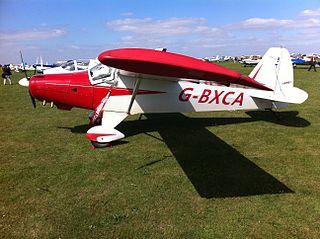
The Viking SF-2A Cygnet, also called the Sisler SF-2A Cygnet and the HAPI SF-2A Cygnet, is an American STOL amateur-built aircraft, designed by Bert Sisler and produced by Viking Aircraft LLC. The aircraft is supplied in the form of plans for amateur construction. The Cygnet first flew in 1973.
The Harmon Der Donnerschlag is an American homebuilt aircraft that was designed and produced by Harmon Engineering of Howe, Texas. The aircraft was intended for amateur construction.
References
- ↑ Federal Aviation Administration (10 November 2014). "Make / Model Inquiry Results" . Retrieved 10 November 2014.
- ↑ Taylor 1976, p. 514.
- Taylor, John W. R. (1976). Jane's All The World's Aircraft 1976–77. London: Jane's Yearbooks. ISBN 0-354-00538-3.
- Aircraft World Directory